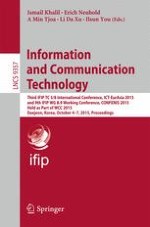This book constitutes the refereed proceedings of the Third IFIP TC 5/8 International Conference on Information and Communication Technology, ICT-EurAsia 2015, with the collocation of AsiaARES 2015 as a special track on Availability, Reliability and Security, and the 9th IFIP WG 8.9 Working Conference on Research and Practical Issues of Enterprise Information Systems, CONFENIS 2015, held as part of the 23rd IFIP World Computer Congress, WCC 2015, in Daejeon, Korea, in October 2015. The 35 revised full papers presented were carefully reviewed and selected from 84 submissions. The papers have been organized in the following topical sections: networks and systems architecture; teaching and education; authentication and profiling; data management and information advertizing; applied modeling and simulation; network security; dependable systems and applications, multimedia security; cryptography; big data and text mining, and social impact of EIS and visualization.
